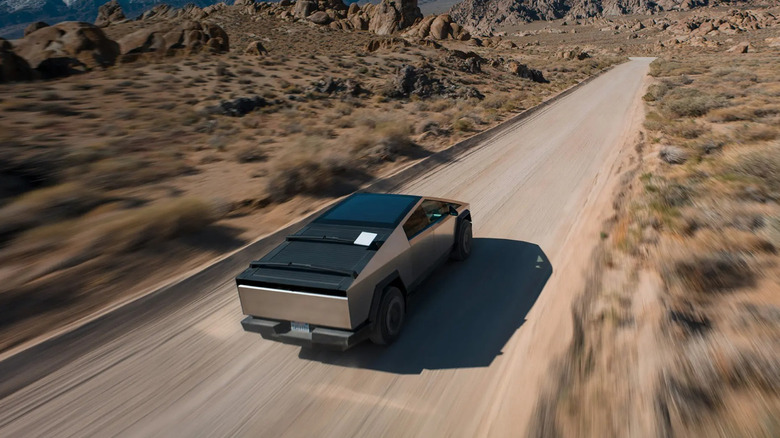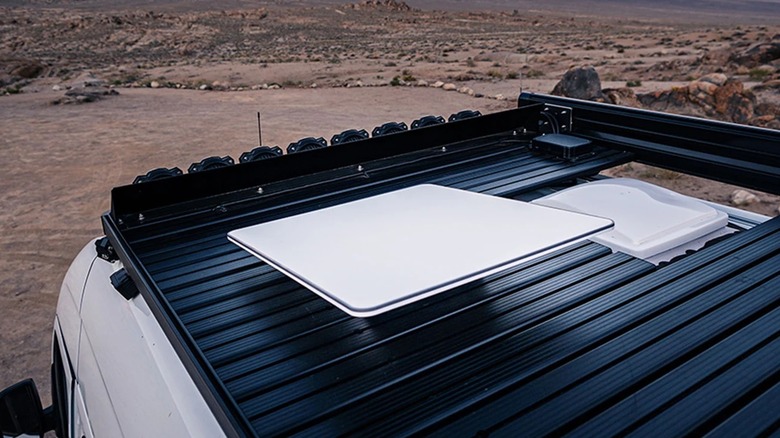What Is Starlink's Performance Kit And Do You Really Need It?
While both are wireless internet services, there's a considerable difference between the speeds of 5G and Starlink. A 5G network can reach over 1 Gbps, but Starlink's speeds typically fall below the gigabit mark. That, however, is set to change with the introduction of the new Starlink Performance Kit. It's a higher-performing model than the popular Standard dish, allowing users to theoretically get gigabit speeds.
Just like the other Starlink kits, the Performance Kit comes complete with the Starlink dish itself, along with the power supply, dish mount, and Ethernet, Starlink, and power cables. If you added the free Starlink Gen 3 router as an additional accessory before checkout, that will be included in your kit too. This makes setting up the dish quick and easy, even for new customers.
The problem, though, is that the Performance Kit is currently priced at $1,999, a considerable bump compared to the Flat High Performance at $1,499. So, before you go about ordering one for your home or business, let's go over what this new kit offers and if it's really a need or just a fancy non-essential upgrade.
The new Starlink Performance Kit, explained
Recently added to the lineup of available Starlink dishes is the Starlink Performance Gen 3, the latest model after the Performance Gen 2 (previously called Flat High Performance) and Performance Gen 1 (originally named Actuated High Performance). According to Starlink, the Performance Gen 3 is its "fastest and most rugged" kit yet, and for good reason.
In terms of internet speed, the hardware can deliver download rates of 475 Mbps and upload rates of 75 Mbps, an improvement over the Performance Gen 2's speeds of 450 Mbps and 60 Mbps. Starlink does mention that the Performance Gen 3 is also capable of up to 1 Gbps, starting in 2026 when network enhancements are implemented.
When it comes to weather resistance, the Performance Gen 3 outperforms all the other releases. Its dish is rated at IP68 when unplugged and IP69K when connected to the ruggedized cables. IP68 means it's completely dust-proof and can be safely submerged in up to 3.6ft (1.1m) of water for over half an hour. Meanwhile, IP69K indicates that the dish is dust-proof and can withstand high-pressure and high-temperature water jets over 1160 PSI (8 MPa) and 176°F (80°C). Material-wise, the Starlink dish is made out of aluminum, making it even more tolerant to harsh weather conditions.
Another new feature that sets the Performance Gen 3 apart from its predecessors is its advanced power supply. Instead of just relying on AC power, the Gen 3 power supply accepts both AC and DC inputs. You can either plug it into a standard wall outlet or use a battery pack with an output of 12 to 56V.
As of this writing, the Starlink Performance Kit is exclusively offered in the United States as a hardware option for the Business and Enterprise plans. If you're already a Starlink customer using earlier generations of the Performance Kit, you can upgrade your hardware with a Field Termination Kit (will soon be available for purchase). This will let you connect the new dish to your existing cables.
Do you really need the Starlink Performance Kit?
Unfortunately, there's no word yet about when the Performance Gen 3 will be available for residential users. So until then, is it even worth it to upgrade to the Starlink Business or Enterprise accounts just to get your hands on this new hardware? Well, it depends on your usage and needs.
If you live somewhere with extreme weather and temperatures, the Performance Gen 3 is the model to go with. It's built to operate within a temperature range of -40°F to 140°F, significantly wider than the -22°F to 122°F range of the Starlink Standard and Performance Gen 1 and 2. The dish also features improved snow-melting capabilities. Where previous generations could only melt three inches an hour, it can now do up to 5.2 inches an hour, depending on the snow density. Hail as big as 1.25 inches in diameter and wind as strong as 170mph also have no effect on the dish's performance. Plus, the hardware's IP68 and IP69K rating ensures the Starlink is safe from water and dust exposure.
Besides extreme weather locations, the Starlink Performance Gen 3 is durable enough in certain settings as well. You can install it on a boat — it's rated to withstand 3,000 hours of salt spray (fog) testing and 400 hours of acidified synthetic sea water. You can use it on off-road in-motion vehicles — it's tested to endure severe mechanical stress from vibration and shock. You might find the Performance Gen 3 convenient for RV living and off-grid locations as well, thanks to its DC power support (no more lugging around a bulky inverter!).
If you're looking for higher internet speeds than what your current Starlink model provides, you can choose to upgrade to the Performance Gen 3, especially since it will greatly benefit from Starlink's new network developments.


